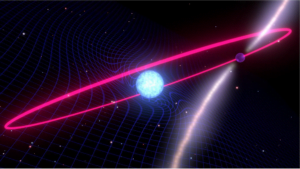Project area/S
- Pulsars and Fast Transients
Project Details
Pulsars in compact binary orbits with another neutron star or white dwarf make unique and powerful laboratories for performing exquisite tests of general relativity, especially in the strong-field regime. The phenomenon of geodetic precession resulting from relativistic spin-orbit coupling make these systems rare, short-lived, objects. Such phenomena provide excellent opportunities for mapping out the two-dimensional beam geometry of pulsar radio emission. The eccentric neutron star-white dwarf binary system PSR J1141-6545 (discovered in 2000) in which a young neutron star is in a four-hour orbit with a massive white-dwarf, shows this phenomenon in remarkable detail, the detailed modelling of which suggests that the system will soon precess out of our view in the next few years. In this project, you will analyse new observational data obtained with the Murchison Widefield Array (MWA) – Australia’s Precursor for the Square Kilometre Array (SKA) telescope, in an effort to discern and assess the observational signatures of precession in these data, and to gauge the prospects and significance of performing a longer-term monitoring in the coming years. Alongside providing indirect tests of general relativity, this will also allow us to further refine the model predictions and contribute toward mapping out the pulsar emission beam geometry.
Student Attributes
Academic Background
Preferably astronomy/physics background
Computing Skills
Experience with Unix or linux, python
Training Requirement
Using supercomputing systems
Project Timeline
- Week 1 Inductions and project introduction
- Week 2 Background reading and Initial Presentation
- Week 3 Familiarize with pulsars, pulsar-binary systems, and how such systems are used for testing the theories of gravity
- Week 4 Familiarize with the operational and processing aspects of high time resolution data from the MWA and the pipeline in use
- Week 5 Process high-time resolution data recorded on the binary pulsar of interest, with focus on data calibration, and quality checks
- Week 6 Progress to processing multiple observations (taken over a time span of ~ 6 months), to make pulsar high-quality detections
- Week 7 Analyze the data to produce integrated pulse profiles that can be compared with the published data at high frequencies
- Week 8 Analyze and characterize data for pulse profile variability, and its implications for relativistic spin precession and beam modelling
- Week 9 Final Presentation
- Week 10 Final Report

